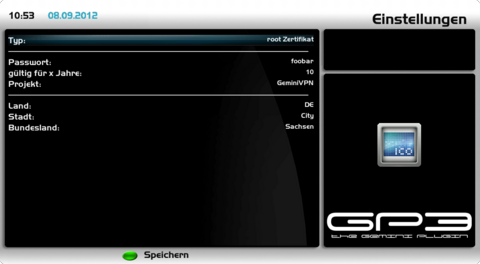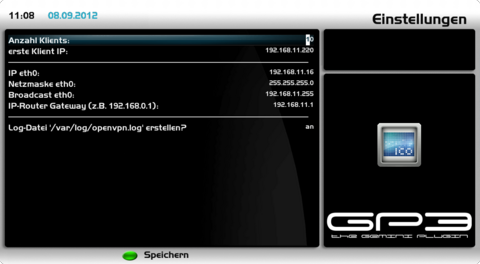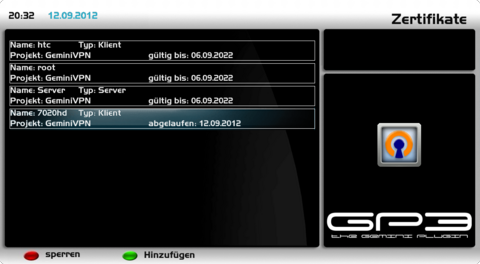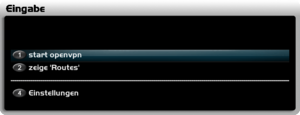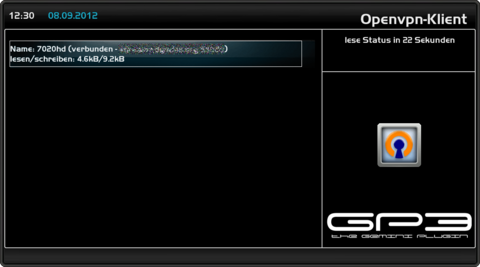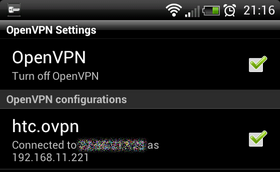GP3.2 OpenVPN (en): Unterschied zwischen den Versionen
Mfgeg (Diskussion | Beiträge) K |
|||
| Zeile 1: | Zeile 1: | ||
[[Kategorie:Index]] | [[Kategorie:Index]] | ||
| − | [[Kategorie:FAQ | + | [[Kategorie:FAQ and instructions]] |
| − | [[Kategorie: | + | [[Kategorie:Basis knowledge]] |
{|width="40%" | {|width="40%" | ||
|[[Bild:deutsch.png]] - [[GP3.2 OpenVPN|in Deutsch]] | |[[Bild:deutsch.png]] - [[GP3.2 OpenVPN|in Deutsch]] | ||
| Zeile 8: | Zeile 8: | ||
{|width=99% | {|width=99% | ||
<div style="margin: 0; margin-right:10px; border: 1px solid #dfdfdf; padding: 1em 1em 1em; background-color:#F8F8FF; align:right;">[[Bild:Artikel_Hinweis.png|right|40px|The Gemini Project]] | <div style="margin: 0; margin-right:10px; border: 1px solid #dfdfdf; padding: 1em 1em 1em; background-color:#F8F8FF; align:right;">[[Bild:Artikel_Hinweis.png|right|40px|The Gemini Project]] | ||
| − | === | + | === Configure OpenVPN Server and client === |
</div> | </div> | ||
|- | |- | ||
| Zeile 18: | Zeile 18: | ||
After installing the '''geminiopenvpn''' Plugin you have an [http://en.wikipedia.org/wiki/OpenVPN OpenVPN] Server or Client which is easy to configure. The plugin uses [http://en.wikipedia.org/wiki/Public_key_certificate certificates] (Server-Multi-Client). The connection on the OpenVPN Server is made over an encrypted [http://en.wikipedia.org/wiki/Transport_Layer_Security TLS] connection. | After installing the '''geminiopenvpn''' Plugin you have an [http://en.wikipedia.org/wiki/OpenVPN OpenVPN] Server or Client which is easy to configure. The plugin uses [http://en.wikipedia.org/wiki/Public_key_certificate certificates] (Server-Multi-Client). The connection on the OpenVPN Server is made over an encrypted [http://en.wikipedia.org/wiki/Transport_Layer_Security TLS] connection. | ||
| − | For connections the OpenVPN Server Plugin creates a virtual network interface (tap0), which is connected over a network bridge (br0) with the internal network adapter (eth0) of the Dreambox. One or more OpenVPN clients get an IP | + | For connections the OpenVPN Server Plugin creates a virtual network interface (tap0), which is connected over a network bridge (br0) with the internal network adapter (eth0) of the Dreambox. One or more OpenVPN clients get an IP address of the internal network and can access all available services without additional routing. |
The mode used by OpenVPN is [http://en.wikipedia.org/wiki/OpenVPN#Bridging Bridging]. With this mode the [http://en.wikipedia.org/wiki/Broadcast Broadcasts] are forwarded without any problem. Same for network protocols like IPv4, IPv6, Netalk, IPX, ... | The mode used by OpenVPN is [http://en.wikipedia.org/wiki/OpenVPN#Bridging Bridging]. With this mode the [http://en.wikipedia.org/wiki/Broadcast Broadcasts] are forwarded without any problem. Same for network protocols like IPv4, IPv6, Netalk, IPX, ... | ||
| Zeile 36: | Zeile 36: | ||
Back to [[#top | table of contents]] | Back to [[#top | table of contents]] | ||
| + | |||
= OpenVPN Server = | = OpenVPN Server = | ||
| Zeile 48: | Zeile 49: | ||
== Create Root Certificate == | == Create Root Certificate == | ||
| − | [[Bild:GP3 OpenVPN root Zertifikat.png|thumb|none|root | + | [[Bild:GP3 OpenVPN root Zertifikat.png|thumb|none|root certificate - Skin example: gp-skin-dmconcinnity-mod|480px]] |
Now we create the keys and certificates for the [http://en.wikipedia.org/wiki/Zertifizierungsstelle Certificate Authority] (CA). Open the '''OpenVPN Server''' Plugin and push the '''[green]''' button for certificates. | Now we create the keys and certificates for the [http://en.wikipedia.org/wiki/Zertifizierungsstelle Certificate Authority] (CA). Open the '''OpenVPN Server''' Plugin and push the '''[green]''' button for certificates. | ||
| Zeile 59: | Zeile 60: | ||
|- style="text-align:center; margin:1em 1em 1em 0; background:#FFFFFF" | |- style="text-align:center; margin:1em 1em 1em 0; background:#FFFFFF" | ||
| width="70px" | '''Password''' | | width="70px" | '''Password''' | ||
| − | | width="600px" | Enter a Password. Memorize the password, you will need the password for creating Server and Client certificates or for blocking a | + | | width="600px" | Enter a Password. Memorize the password, you will need the password for creating Server and Client certificates or for blocking a certificate. |
|- style="text-align:center; margin:1em 1em 1em 0; background:#FFFFFF" | |- style="text-align:center; margin:1em 1em 1em 0; background:#FFFFFF" | ||
| width="70px" | '''valid for x years''' | | width="70px" | '''valid for x years''' | ||
| Zeile 78: | Zeile 79: | ||
Save the settings with the '''[green]''' button. The corresponding files will be created and saved in the directory /etc/ssl/openvpn. | Save the settings with the '''[green]''' button. The corresponding files will be created and saved in the directory /etc/ssl/openvpn. | ||
| + | |||
Back to [[#top | table of contents]] | Back to [[#top | table of contents]] | ||
| Zeile 83: | Zeile 85: | ||
== Create Server Certificate == | == Create Server Certificate == | ||
| − | [[Bild:GP3 OpenVPN Server Zertifikat.png|thumb|none|Server | + | [[Bild:GP3 OpenVPN Server Zertifikat.png|thumb|none|Server certificate|480px]] |
Open the '''OpenVPN Server''' Plugin and push the '''[green]''' button for certificates. Push again the '''[green]''' button and choose as type the setting '''Server''' and change the settings as described in the list. | Open the '''OpenVPN Server''' Plugin and push the '''[green]''' button for certificates. Push again the '''[green]''' button and choose as type the setting '''Server''' and change the settings as described in the list. | ||
| Zeile 104: | Zeile 106: | ||
== Create Client Certificate(s) == | == Create Client Certificate(s) == | ||
| − | [[Bild:GP3 OpenVPN Klient Zertifikat.png|thumb|none| | + | [[Bild:GP3 OpenVPN Klient Zertifikat.png|thumb|none|Client certificate|480px]] |
Open the '''OpenVPN Server''' Plugin and push the '''[green]''' button for certificates. Push again the '''[green]''' button and choose as type the setting '''Client''' and change the settings as described in the list. | Open the '''OpenVPN Server''' Plugin and push the '''[green]''' button for certificates. Push again the '''[green]''' button and choose as type the setting '''Client''' and change the settings as described in the list. | ||
| Zeile 122: | Zeile 124: | ||
Save the settings with the '''[green]''' button to create the certificates. You will be prompted to enter the password (which was entered while creating the '''root certificate'''). When a wrong password is entered the following error message is displayed: '''can't generate certificate'''. | Save the settings with the '''[green]''' button to create the certificates. You will be prompted to enter the password (which was entered while creating the '''root certificate'''). When a wrong password is entered the following error message is displayed: '''can't generate certificate'''. | ||
| − | When the correct password is entered the | + | When the correct password is entered the client certificate, key and configuration file can be found in the following directory: |
/etc/ssl/openvpn | /etc/ssl/openvpn | ||
| Zeile 139: | Zeile 141: | ||
|- style="text-align:center; margin:1em 1em 1em 0; background:#FFFFFF" | |- style="text-align:center; margin:1em 1em 1em 0; background:#FFFFFF" | ||
| width="70px" | '''7020hd.ovpn''' | | width="70px" | '''7020hd.ovpn''' | ||
| − | | width="600px" | | + | | width="600px" | Configuration file for the client. |
If multiple certificates for multiple clients are created, every name needs to be '''different'''. | If multiple certificates for multiple clients are created, every name needs to be '''different'''. | ||
|- style="text-align:center; margin:1em 1em 1em 0; background:#F0F0F0" | |- style="text-align:center; margin:1em 1em 1em 0; background:#F0F0F0" | ||
| Zeile 145: | Zeile 147: | ||
| width="600px" | The Root Certificate. | | width="600px" | The Root Certificate. | ||
|} | |} | ||
| + | |||
| + | |||
| + | Back to [[#top | table of contents]] | ||
| + | |||
== Overview of the configuration == | == Overview of the configuration == | ||
| − | [[Bild:GP3 OpenVPN Konfigurationsübersicht.png|thumb|none| | + | [[Bild:GP3 OpenVPN Konfigurationsübersicht.png|thumb|none|Overview of the configuration|480px]] |
The created configurations can be displayed with the '''[green]''' button (certificates) in the OpenVPN Server Plugin. The example shows the configuration for a root certificate, Server settings and the configuration of two clients, with the names htc and 7020hd. | The created configurations can be displayed with the '''[green]''' button (certificates) in the OpenVPN Server Plugin. The example shows the configuration for a root certificate, Server settings and the configuration of two clients, with the names htc and 7020hd. | ||
| Zeile 153: | Zeile 159: | ||
Back to [[#top | table of contents]] | Back to [[#top | table of contents]] | ||
| + | |||
== Settings == | == Settings == | ||
| − | [[Bild:GP3 OpenVPN Einstellungen.png|thumb|none|OpenVPN | + | [[Bild:GP3 OpenVPN Einstellungen.png|thumb|none|OpenVPN settings|480px]] |
Open the '''OpenVPN Server''' Plugin in the BluePanel under the daemons. Now we check first the settings, before starting the OpenVPN Server. Push the '''[blue]''' button and choose the point '''[Settings]'''. Use the following list for the descriptions and modify if requires. The network settings should be taken from the Dreambox and should '''only''' be changed in rare occasions. | Open the '''OpenVPN Server''' Plugin in the BluePanel under the daemons. Now we check first the settings, before starting the OpenVPN Server. Push the '''[blue]''' button and choose the point '''[Settings]'''. Use the following list for the descriptions and modify if requires. The network settings should be taken from the Dreambox and should '''only''' be changed in rare occasions. | ||
| Zeile 167: | Zeile 174: | ||
|- style="text-align:center; margin:1em 1em 1em 0; background:#FFFFFF" | |- style="text-align:center; margin:1em 1em 1em 0; background:#FFFFFF" | ||
| width="70px" | '''first client IP''' | | width="70px" | '''first client IP''' | ||
| − | | width="600px" | From this IP | + | | width="600px" | From this IP address on the IP's are assigned to the clients. '''Attention''' make sure this range is not overlapping with the dhcp server of the network! |
|- style="text-align:center; margin:1em 1em 1em 0; background:#F0F0F0" | |- style="text-align:center; margin:1em 1em 1em 0; background:#F0F0F0" | ||
| width="70px" | '''IP eth0''' | | width="70px" | '''IP eth0''' | ||
| − | | width="600px" | The IP Adress of the Dreambox for the lan interface (eth0). This | + | | width="600px" | The IP Adress of the Dreambox for the lan interface (eth0). This address is only used for the network bridge (br0). |
| − | Keep in mind the local network card has no IP | + | Keep in mind the local network card has no IP address in this mode, don't panic when checking the network adapter with '''ifconfig'''. |
|- style="text-align:center; margin:1em 1em 1em 0; background:#F0F0F0" | |- style="text-align:center; margin:1em 1em 1em 0; background:#F0F0F0" | ||
| width="70px" | '''Netzmaske eth0''' | | width="70px" | '''Netzmaske eth0''' | ||
| Zeile 178: | Zeile 185: | ||
|- style="text-align:center; margin:1em 1em 1em 0; background:#F0F0F0" | |- style="text-align:center; margin:1em 1em 1em 0; background:#F0F0F0" | ||
| width="70px" | '''Broadcast eth0''' | | width="70px" | '''Broadcast eth0''' | ||
| − | | width="600px" | Enter the broadcast | + | | width="600px" | Enter the broadcast address of the local network. |
|- style="text-align:center; margin:1em 1em 1em 0; background:#F0F0F0" | |- style="text-align:center; margin:1em 1em 1em 0; background:#F0F0F0" | ||
| width="70px" | '''IP Router Gateway''' | | width="70px" | '''IP Router Gateway''' | ||
| − | | width="600px" | Enter the IP | + | | width="600px" | Enter the IP address of the routers. |
|- style="text-align:center; margin:1em 1em 1em 0; background:#FFFFFF" | |- style="text-align:center; margin:1em 1em 1em 0; background:#FFFFFF" | ||
| width="70px" | '''Log File''' | | width="70px" | '''Log File''' | ||
| Zeile 187: | Zeile 194: | ||
|} | |} | ||
| − | Save the settings with the '''[green]''' button. After saving the settings the OpenVPN Server is started automatically. The OpenVPN Server will also be started automatically after restarting the Dreambox, when a | + | Save the settings with the '''[green]''' button. After saving the settings the OpenVPN Server is started automatically. The OpenVPN Server will also be started automatically after restarting the Dreambox, when a configuration file and certificates are available. |
| − | {{Hinweis|'''Restart the Dreambox'''<br/>The OpenVPN Server will also be started '''automatically''' after restarting the Dreambox, when a | + | {{Hinweis|'''Restart the Dreambox'''<br/>The OpenVPN Server will also be started '''automatically''' after restarting the Dreambox, when a configuration file and certificates are available.}} |
| Zeile 195: | Zeile 202: | ||
== OpenVPN Log File == | == OpenVPN Log File == | ||
| − | [[Bild:GP3 OpenVPN Logdatei.png|thumb|none| | + | [[Bild:GP3 OpenVPN Logdatei.png|thumb|none|Log file|620px]] |
| − | Informations about the status of the OpenVPN server can be displayed with the '''[red]''' button (Log file). The example shows the OpenVPN server was started | + | Informations about the status of the OpenVPN server can be displayed with the '''[red]''' button (Log file). The example shows the OpenVPN server was started successful with two connected clients. |
The log file can also be displayed in the terminal with the following command: | The log file can also be displayed in the terminal with the following command: | ||
| Zeile 205: | Zeile 212: | ||
Back to [[#top | table of contents]] | Back to [[#top | table of contents]] | ||
| + | |||
== Overview of connections == | == Overview of connections == | ||
| − | [[Bild:GP3 OpenVPN Verbindungsübersicht.png|thumb|none| | + | [[Bild:GP3 OpenVPN Verbindungsübersicht.png|thumb|none|Active connections|480px]] |
The OpenVPN Server Plugin controls regularly if clients are connected and shows the connections as in the image '''Active connections'''. In this example two clients are connected, with the name htc and 7020hd. | The OpenVPN Server Plugin controls regularly if clients are connected and shows the connections as in the image '''Active connections'''. In this example two clients are connected, with the name htc and 7020hd. | ||
| Zeile 213: | Zeile 221: | ||
Back to [[#top | table of contents]] | Back to [[#top | table of contents]] | ||
| + | |||
== Block certificate(s) == | == Block certificate(s) == | ||
| − | [[Bild:GP3 OpenVPN Klient sperren.png|thumb|none| | + | [[Bild:GP3 OpenVPN Klient sperren.png|thumb|none|Expired certificate|480px]] |
| − | |||
| − | |||
| + | Certificates can be blocked, when you want to deny access from a client. Blocking is done over the '''[red]''' button, when the menu of the certificates is opened. Blocked client certificates are displayed as '''expired'''. For blocking the correct password (which was used for creating the root certificate) needs to be entered. | ||
{{Achtung|1='''Blocking certificates'''<br/>blocked certificates can '''not''' be reactivated. They need to be '''recreated'''!}} | {{Achtung|1='''Blocking certificates'''<br/>blocked certificates can '''not''' be reactivated. They need to be '''recreated'''!}} | ||
| Zeile 224: | Zeile 232: | ||
Back to [[#top | table of contents]] | Back to [[#top | table of contents]] | ||
| + | |||
== OpenVPN Server - Menu button == | == OpenVPN Server - Menu button == | ||
| − | [[Bild:GP3 OpenVPN Server starten.png|thumb|none| | + | [[Bild:GP3 OpenVPN Server starten.png|thumb|none|Menu button|300px]] |
Open the OpenVPN Server Plugin and push the '''[blue]''' button of the remote control. The functions are described in the following list. | Open the OpenVPN Server Plugin and push the '''[blue]''' button of the remote control. The functions are described in the following list. | ||
| Zeile 235: | Zeile 244: | ||
|- style="text-align:center; margin:1em 1em 1em 0; background:#FFFFFF" | |- style="text-align:center; margin:1em 1em 1em 0; background:#FFFFFF" | ||
| width="70px" | '''start / stop openvpn''' | | width="70px" | '''start / stop openvpn''' | ||
| − | | width="600px" | With this entry you can stop/start the OpenVPN | + | | width="600px" | With this entry you can stop/start the OpenVPN server manually. |
|- style="text-align:center; margin:1em 1em 1em 0; background:#FFFFFF" | |- style="text-align:center; margin:1em 1em 1em 0; background:#FFFFFF" | ||
| width="70px" | '''show 'Routes'''' | | width="70px" | '''show 'Routes'''' | ||
| − | | width="600px" | Shows [http://en.wikipedia.org/wiki/Routing Routing] informations of the | + | | width="600px" | Shows [http://en.wikipedia.org/wiki/Routing Routing] informations of the network bridge (br0). |
|- style="text-align:center; margin:1em 1em 1em 0; background:#FFFFFF" | |- style="text-align:center; margin:1em 1em 1em 0; background:#FFFFFF" | ||
| width="70px" | '''Settings''' | | width="70px" | '''Settings''' | ||
| − | | width="600px" | Settings for the OpenVPN | + | | width="600px" | Settings for the OpenVPN server. |
|} | |} | ||
Back to [[#top | table of contents]] | Back to [[#top | table of contents]] | ||
| + | |||
== Delete certificates == | == Delete certificates == | ||
| Zeile 255: | Zeile 265: | ||
Back to [[#top | table of contents]] | Back to [[#top | table of contents]] | ||
| + | |||
= OpenVPN Client = | = OpenVPN Client = | ||
| Zeile 267: | Zeile 278: | ||
/etc/openvpn | /etc/openvpn | ||
| − | Once | + | Once more the list of the required 4 files for the OpenVPN client. The xxx stands for the name which was given for the client. |
* xxx-cert.pem | * xxx-cert.pem | ||
| Zeile 278: | Zeile 289: | ||
| − | === Edit | + | === Edit configuration file === |
| − | Before setting up a connection the | + | Before setting up a connection the configuration file (*.ovpn) needs to be edited. The line '''remote''' needs to be completed with the IP address or the host address and the correct port. the configuration could be similar to the example, when the access uses the host name webaccess.dyndns.tv via port 1194. |
. | . | ||
| Zeile 297: | Zeile 308: | ||
Back to [[#top | table of contents]] | Back to [[#top | table of contents]] | ||
| + | |||
=== Make connection === | === Make connection === | ||
| − | [[Bild:GP3 OpenVPN Klient Dreambox.png|thumb|none|Dreambox Client - Skin | + | [[Bild:GP3 OpenVPN Klient Dreambox.png|thumb|none|Dreambox Client - Skin example: gp-skin-swan-black|480px]] |
| − | Open the '''OpenVPN Client''' Plugin in the BluePanel under Daemons. In the Plugin a line (not connected) appears, when the | + | Open the '''OpenVPN Client''' Plugin in the BluePanel under Daemons. In the Plugin a line (not connected) appears, when the configuration files were copied in the correct directory (/etc/openvpn). |
| − | Start the connection with the OpenVPN Server with the '''[OK]''' button. If everything starts the status ''' | + | Start the connection with the OpenVPN Server with the '''[OK]''' button. If everything starts the status '''connected''' is displayed in the OpenVPN Client Plugin. Disconnecting is possible by pressing the '''[OK]''' button again. |
| − | {{Hinweis|'''Connection after reboot'''<br/>The connection is restored '''automatically''' after a reboot of the Dreambox, if a config file (*.ovpn) is | + | {{Hinweis|'''Connection after reboot'''<br/>The connection is restored '''automatically''' after a reboot of the Dreambox, if a config file (*.ovpn) is available in /etc/openvpn.}} |
Back to [[#top | table of contents]] | Back to [[#top | table of contents]] | ||
| + | |||
== Android Smartphone as client == | == Android Smartphone as client == | ||
| − | [[Bild:GP3 OpenVPN Klient Android.png|thumb|none| | + | [[Bild:GP3 OpenVPN Klient Android.png|thumb|none|Example - OpenVPN settings Android|280px]] |
| + | |||
| + | The image shows an example of an Android based Smartphone, which is connected with the Dreambox. As App is used [http://code.google.com/p/android-openvpn-settings/ OpenVPN settings] to connect with the Server. Keep in mind the Smartphone needs to be rooted to use OpenVPN. Additional the tun/tap driver, the Busybox and [https://play.google.com/store/apps/details?id=de.schaeuffelhut.android.openvpn.installer&feature=related_apps#?t=W251bGwsMSwxLDEwOSwiZGUuc2NoYWV1ZmZlbGh1dC5hbmRyb2lkLm9wZW52cG4uaW5zdGFsbGVyIl0. OpenVPN] is required. With many [http://en.wikipedia.org/wiki/Custom-Rom Custom-Roms] these requirements are already integrated in the Firmware. | ||
| − | The | + | The config file (*.opvn) needs to be edited with the correct server and port. Copy the client files on the SD card, e.g. in a directory openvpn. Now you need to adapt the OpenVPN App (e.g. path to the configuration, certificates) and the tunnel on the OpenVPN Server can be started. |
| − | |||
| + | Back to [[#top | table of contents]] | ||
| − | |||
= Support thread = | = Support thread = | ||
Version vom 16. September 2012, 22:07 Uhr
InhaltsverzeichnisAfter installing the geminiopenvpn Plugin you have an OpenVPN Server or Client which is easy to configure. The plugin uses certificates (Server-Multi-Client). The connection on the OpenVPN Server is made over an encrypted TLS connection. For connections the OpenVPN Server Plugin creates a virtual network interface (tap0), which is connected over a network bridge (br0) with the internal network adapter (eth0) of the Dreambox. One or more OpenVPN clients get an IP address of the internal network and can access all available services without additional routing. The mode used by OpenVPN is Bridging. With this mode the Broadcasts are forwarded without any problem. Same for network protocols like IPv4, IPv6, Netalk, IPX, ...
Requirements for using OpenVPN
OpenVPN ServerInstall the OpenVPN Plugin via BluePanel and configure the Server as described. After rebooting you find the OpenVPN Server (and client) in the BluePanel. It's also possible to install the plguin over the console with the following command: opkg update && opkg install geminiopenvpn
Create Root CertificateNow we create the keys and certificates for the Certificate Authority (CA). Open the OpenVPN Server Plugin and push the [green] button for certificates. Choose root-certificate and change the settings as described in the list. For all parameters only letters and numbers can be used.
Save the settings with the [green] button. The corresponding files will be created and saved in the directory /etc/ssl/openvpn.
Create Server CertificateOpen the OpenVPN Server Plugin and push the [green] button for certificates. Push again the [green] button and choose as type the setting Server and change the settings as described in the list.
Save the settings with the [green] button to create the certificates. You will be prompted to enter the password (which was entered while creating the root certificate). When a wrong password is entered the following error message is displayed: can't generate certificate. When the correct password is entered the certificates, keys and the Diffie-Hellman parameters are created. This can take some minutes (up to 30 min), the status is displayed in the plugin. The plugin can be closed while the creation is in progress, the process continues in background.
Create Client Certificate(s)Open the OpenVPN Server Plugin and push the [green] button for certificates. Push again the [green] button and choose as type the setting Client and change the settings as described in the list.
Save the settings with the [green] button to create the certificates. You will be prompted to enter the password (which was entered while creating the root certificate). When a wrong password is entered the following error message is displayed: can't generate certificate. When the correct password is entered the client certificate, key and configuration file can be found in the following directory: /etc/ssl/openvpn These files (three files for each client) will be used later on the OpenVPN clients to set up a connection with the server. The needed files look like follows, e.g. if the entered name was 7020hd. In addition to the three files every client needs the Root Certificate (vpn-ca.pem).
Overview of the configurationThe created configurations can be displayed with the [green] button (certificates) in the OpenVPN Server Plugin. The example shows the configuration for a root certificate, Server settings and the configuration of two clients, with the names htc and 7020hd.
SettingsOpen the OpenVPN Server Plugin in the BluePanel under the daemons. Now we check first the settings, before starting the OpenVPN Server. Push the [blue] button and choose the point [Settings]. Use the following list for the descriptions and modify if requires. The network settings should be taken from the Dreambox and should only be changed in rare occasions.
Save the settings with the [green] button. After saving the settings the OpenVPN Server is started automatically. The OpenVPN Server will also be started automatically after restarting the Dreambox, when a configuration file and certificates are available.
OpenVPN Log FileInformations about the status of the OpenVPN server can be displayed with the [red] button (Log file). The example shows the OpenVPN server was started successful with two connected clients. The log file can also be displayed in the terminal with the following command: cat /var/log/openvpn.log
Overview of connectionsThe OpenVPN Server Plugin controls regularly if clients are connected and shows the connections as in the image Active connections. In this example two clients are connected, with the name htc and 7020hd.
Block certificate(s)Certificates can be blocked, when you want to deny access from a client. Blocking is done over the [red] button, when the menu of the certificates is opened. Blocked client certificates are displayed as expired. For blocking the correct password (which was used for creating the root certificate) needs to be entered.
OpenVPN Server - Menu buttonOpen the OpenVPN Server Plugin and push the [blue] button of the remote control. The functions are described in the following list.
Delete certificatesCertificates can not be deleted in the OpenVPN Server Plugin. The files need to be deleted manually in the directory: /etc/openvpn/ssl
OpenVPN ClientThere are many different OpenVPN Frontends, for different operation systems, to connect with a OpenVPN Server. The following points describe the configuration of the OpenVPN client on a Dreambox (with the GP3.2 Plugin) and an Android based Smartphone.
Dreambox as clientWhen configuring the OpenVPN clients you need to copy the 4 files created on the server before in the directory of the client: /etc/openvpn Once more the list of the required 4 files for the OpenVPN client. The xxx stands for the name which was given for the client.
Edit configuration fileBefore setting up a connection the configuration file (*.ovpn) needs to be edited. The line remote needs to be completed with the IP address or the host address and the correct port. the configuration could be similar to the example, when the access uses the host name webaccess.dyndns.tv via port 1194. .
.
# example 'remote foobar.org 1194'
# example 'remote 97.123.100.236 1194'
remote webaccess.dyndns.tv 1194
resolv-retry infinite
nobind
persist-key
persist-tun
.
.
Make connectionOpen the OpenVPN Client Plugin in the BluePanel under Daemons. In the Plugin a line (not connected) appears, when the configuration files were copied in the correct directory (/etc/openvpn). Start the connection with the OpenVPN Server with the [OK] button. If everything starts the status connected is displayed in the OpenVPN Client Plugin. Disconnecting is possible by pressing the [OK] button again.
Android Smartphone as clientThe image shows an example of an Android based Smartphone, which is connected with the Dreambox. As App is used OpenVPN settings to connect with the Server. Keep in mind the Smartphone needs to be rooted to use OpenVPN. Additional the tun/tap driver, the Busybox and OpenVPN is required. With many Custom-Roms these requirements are already integrated in the Firmware. The config file (*.opvn) needs to be edited with the correct server and port. Copy the client files on the SD card, e.g. in a directory openvpn. Now you need to adapt the OpenVPN App (e.g. path to the configuration, certificates) and the tunnel on the OpenVPN Server can be started.
Support threadIf you need help with OpenVPN, follow the link ;) geminiopenvpn
|
